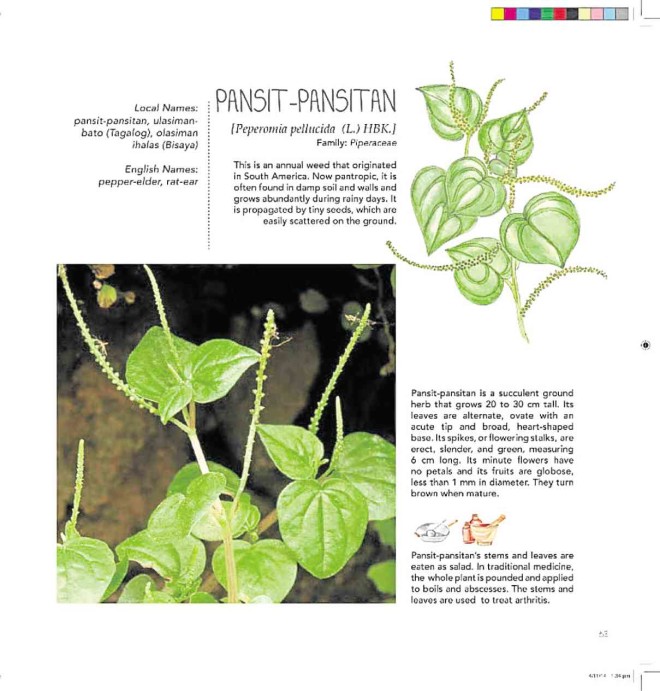
There was a good harvest of quality essays submitted to the Doreen Gamboa Fernandez Food Writing Award on its 13th year.
The subject was herbs. Two past winners, Lolita Lacuesta and Elmer Nocheseda, snagged first prize; while two new contestants, Raymond Aquino Macapagal and Josephine Roque, won second prize.
Nocheseda gives a hint of the many herbs he mentions in the title of his essay, “Quilites, Halom, Oray and other Gugulayin.” He specifies which herbs are used for certain dishes and that he sources them from herb vendors around the Quiapo church—“musky alagaw leaves for our lutong palos na hito; luxuriant kulitis for laoyang pata; bracing bawang na mura for pugtong gurame.”
The dishes are cooked in the vicinity of Laguna de Bai, in his mother’s hometown of Angono and his father’s place in Pateros.
Yet Nocheseda also stresses that “herbs are not mere gugulayin or sahog sa laoya but, more importantly, they are halamang gamut or potent vegetal presence that heals. Herbs are also called halamang gubat or damong ligaw as they are usually not cultivated but found in the wild, and as such, they have katas na mabisa that is teeming and pulsating with life’s potency and vigor.”
Nocheseda is author of the award-winning book “Palaspas: An Appreciation of Palm Leaf Art of the Philippines” (2010), and “Pateros” (2013).
‘Tanglad’
In contrast, Lacuesta chose to write about one herb, tanglad (lemongrass), a flavoring and aromatic ingredient that her mother taught her to use for tinolang manok (stewed chicken): It is the “aroma… we look for, what adds another level to our appreciation and anticipation of a meal.”
Lacuesta enumerates the many dishes that use tanglad because it “figures prominently in rudimentary Philippine cuisine—Ilonggo tinuom nga manok, lechon manok, KBL, binakol, inubaran and kansi; the Cebuano tinowa… and law-uy… the Leyteño pakdol, the Bicol pinangat, and sorol from Camiguin, [Bicol’s] gulay na natong (laing)… and the Muslims’… tiyula… as well as piyanggang manok.”
But of course she also writes about lechon—how, to many people, it wouldn’t be lechon without bunches of tanglad stuffing.
For Lacuesta, tanglad is “flavor enhancer, appetite stimulant, food-as-medicine… a locus for the Filipino, as it identifies, defines and contextualizes the Filipino.”
Lacuesta previously won first place in 2013. She’s a retired teacher at Ateneo de Manila University and the University of the Philippines, and now edits books.
‘Pinespes’
The second-prize winners mirrored their first-prize counterparts. Like Lacuesta, Raymond Aquino Macapagal wrote about only one herb—pinespes which starts off as plain grass, masticated by cows and “through the wonders of a ruminant’s four-chambered stomach, transformed into a piquant herb appreciated by the hardiest of palates.”
Macapagal writes how only grass-fed cows will do since those given commercial feed will not turn out the proper pinespes, and that the grass should have gone through the proper stomach chamber as well, or this will not do for the Ilocano papaitan. In his words, “the once lowly grass is transmogrified, empowered to give a simple entrails soup a pungent flavor to match the strong kick of local libations.”
Macapagal is an assistant professor at the University of the Philippines International Studies.
More herbs
Josephine Roque started out her essay with someone ramming her car at the Bureau of Agricultural Research where she went to inquire about an agriculture chief in Tiaong, Quezon, who made “oregano juice, vinegar and wine products” that can be used to marinate meats and can be a dressing for salad.
She rattles off what herbs are used in certain dishes—a family friend’s roast chicken in Iligan that uses bawing, a kind of basil; and how in Angono, “the young leaves of the alagaw plant are part of the ingredient list for the dishes kanduli na dilawan and ayungin na paksiw.”
In Bulacan, kalamata, “a licorice-tasting herb, is steeped in scalded milk then removed for leche flan.”
And in Vigan, Ilocos Sur, “epazote leaves are crumbled and included with rice wine to finish chicken pipian.”
Roque has a small garden where she claims herbs are easy to grow and don’t require too much attention. Here she gives the funniest line in her essay: “They need little fussing over like a boyfriend with no self-esteem issues.”
Roque is a freelance writer and editor currently pursuing an MFA in Creative Writing at De La Salle University.
Philippine herbs
While the essays gave a lot of information about herbs, there will be much more in the book “Philippine Herbs for Healthy Cooking, Common Cures, and Concoctions” (ArtPost Asia and Aboitiz Equity Ventures, 2015). Its popular edition will be launched in September.
In the book, indigenous and naturalized herbs are identified by Dr. Domingo Madulid, former head and curator of the Philippine National Herbarium and the Botanical division of the National Museum of the Philippines.
Dr. Jaime Galvez Tan, former health secretary and known for his grassroots medical health work, wrote on using herbs for cures and healing. Josefa C. Reyes, a pharmacist and founder of Manila Herbal and Essential Oils, gave recipes for concoctions such as teas and balms.
I contribute a section on herbs in Filipino cooking, with several recipes from different regions including some of those mentioned in the DGF Food Writing Award. There are also tips on how to source and grow herbs specially in urban areas where every nook and cranny and recycled containers can be an herb garden.
E-mail the columnist at pinoyfood04@yahoo.com